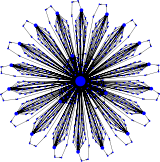Template:EvoLudo/Recent

Evolutionary graph theory
New tutorial added on evolutionary graph theory, which provides a formal approach to describe the spreading and fixation (or extinction) of a mutant type in structured populations. Interestingly, the fixation probabilities remain unaffected by the underlying structure for a large class of graphs. However, some graphs may act either as amplifiers or suppressors of selection by increasing or decreasing the fixation probabilities as compared to unstructured populations. In contrast, fixation and absorption times are very sensitive to changes in the graph structure and hence vary greatly even for graphs that leave fixation probabilities unchanged. Even though fixation times are, in general, not preserved between graphs, symmetries of a graph can at least ensure that fixation times do not depend on the initial location of the mutant. This summarizes research efforts that span over a decade, including:
- McAvoy, A. & Hauert, C. (2015) J. R. Soc. Interface 12 20150420 doi: 10.1098/rsif.2015.0420
- Jamieson-Lane, A. & Hauert, C. (2015) J. Theor. Biol. 382 44-56 doi: 10.1016/j.jtbi.2015.06.029
- Lieberman, E., Hauert, C. & Nowak, M. (2005) Nature 433 312-316 doi: 10.1038/nature03204.